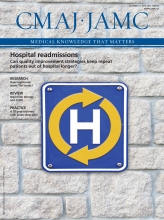See related research article on page E568 and at www.cmaj.ca/lookup/doi/10.1503/cmaj.140289
The past five years in medicine have seen a drive for physicians to distinguish necessary from unnecessary use of health care resources.1 Along with more judicious use of tests and treatments, care providers have been asked to help cut costs by shifting the management of patients with chronic conditions back into the community and reducing avoidable hospital admissions.
In an accompanying research article, Tricco and colleagues investigate which quality improvement strategies for care coordination most effectively curb recurrent use of health care services.2 For their meta-analysis, the authors obtained data for 7494 frequent users of health care services included in 36 randomized clinical trials of strategies to reduce emergency department visits, admissions to hospital or outpatient clinic visits. They found a 20% reduction in the risk of hospital admissions after implementation of interventions involving case management protocols, team changes, promotion of patient self-management or patient education.2 When stratified by type of patient (those with mental illness v. those with chronic medical conditions other than mental illness; age ≥ 65 v. < 65 yr), significant reductions in hospital admissions persisted only among patients with chronic medical conditions other than mental illness. In additional subgroup analyses, a significant reduction in the proportion of patients visiting emergency departments was observed only among patients 65 years and older. None of the interventions studied had an impact on outpatient clinic visits.
The good news for clinicians who grapple with how to keep medical patients out of hospital is threefold. First, offering self-management and patient education about chronic disease is relatively simple. Evidence-based primary care guidelines on how to implement self-management strategies for patients with chronic medical conditions are available online.3,4 Resource material can be downloaded for patients with chronic heart failure, for example,5 and information on how to involve all members of the allied health care team in such strategies is well described.4
Second, Tricco and colleagues’ finding of 31% fewer older patients visiting emergency departments reinforces that older adults respond well to quality improvement interventions. In view of the growing population of older adults with chronic disease, implementation of these solutions could arguably be viewed as the new standard of care. Although the causes of avoidable emergency visits and hospital admissions were not specified in the article, appropriate medication review and deprescription of harmful medications such as sedative–hypnotics are a starting point for educating older adults and preventing unnecessary visits to the emergency department.6,7
Third, clinicians can strategically cite the findings from Tricco and colleagues’ meta-analysis to justify the need for a multidisciplinary care team — including a pharmacist, nurse, physiotherapist, social worker and other allied health professionals — to better coordinate the management of patients at high risk of hospital admission. Discharge planning and involvement of a home-care transition coach — either a nurse or social worker — has been shown to facilitate implementation of the patient’s recovery goals in the community and reduce the risk of recurrent admissions, as well as being cost-effective compared with usual care.8 Disappointingly, the interventions studied in the meta-analysis did not decrease health care use among patients with mental illness. Several strategies were examined — case management, team changes, promotion of self-management, decision support, clinical information systems, patient navigators and outreach activities — but none succeeded in reducing emergency department visits, hospital admissions or clinic visits among patients who were homeless, had substance abuse disorders or had schizophrenia or severe bipolar disorder.2 One explanation why environmental and educational interventions failed to mitigate recurrent health care use by patients with mental illness involves the neurobiology and manifestations of these conditions. Patients with decompensating schizophrenia may experience difficulties communicating, lack of insight, paranoid ideations, uncooperativeness, and social and emotional withdrawal, which would render case management and educational interventions difficult to apply.9 Similar constraints exist for homeless patients and those with substance abuse disorders.
However, clinicians deciding not to implement the quality improvement strategies described in the meta-analysis for patients with mental illness should reconsider. Before the results of any systematic review or meta-analysis can be applied, an assessment needs to be done about the generalizability of the findings to the patient population of interest.10 Clinicians who care primarily for patients with depression and anxiety will note that Tricco and colleagues did not examine the effect of care-coordination interventions on reducing health care use among patients who had depression or anxiety as their primary diagnosis. Only patients who were included in randomized trials based on the diagnosis of one of the _targeted mental health disorders were stratified into the mental illness group for subgroup analysis. As a result, it is difficult to determine with certainty whether the interventions studied would be effective for patients receiving treatment for depression or anxiety alone.
An unspoken question hovering behind the implications of this meta-analysis is “Have we reached consensus on what constitutes value in health care?”11 High-value care for many decision-makers and administrators clearly translates into a reduction in health care utilization. However, for patients and clinicians, high-value care may represent an investment in meaningful doctor–patient relationships, a focus on communication and continuity of care, and long-term interactions that support quality of life, function and independent living. Individuals with mental illness may depend on hospital care for respite and safe supervision when acute episodes of psychosis or depression occur. Until our health care system offers an alternate point of access to these services, or adequately trains and supports caregivers to care for their loved ones at home during periods of illness exacerbation, the revolving door that allows entry into hospital will continue to play an essential role in the care of patients with chronic conditions.
Key points-
A 20% reduction in the risk of hospital admissions among patients with chronic medical conditions can be achieved by applying quality improvement strategies involving case management protocols, team changes, promotion of self-management and educational programs for patients.
-
Older adults stand the most to benefit: a 31% reduction in the risk of emergency department visits is possible with implementation of these initiatives.
-
Clinicians should re-evaluate the interprofessional composition of their practice and implement self-management programs to shift care away from the use of hospital resources.
Footnotes
-
Competing interests: None declared.
-
This article was solicited and has not been peer reviewed.








